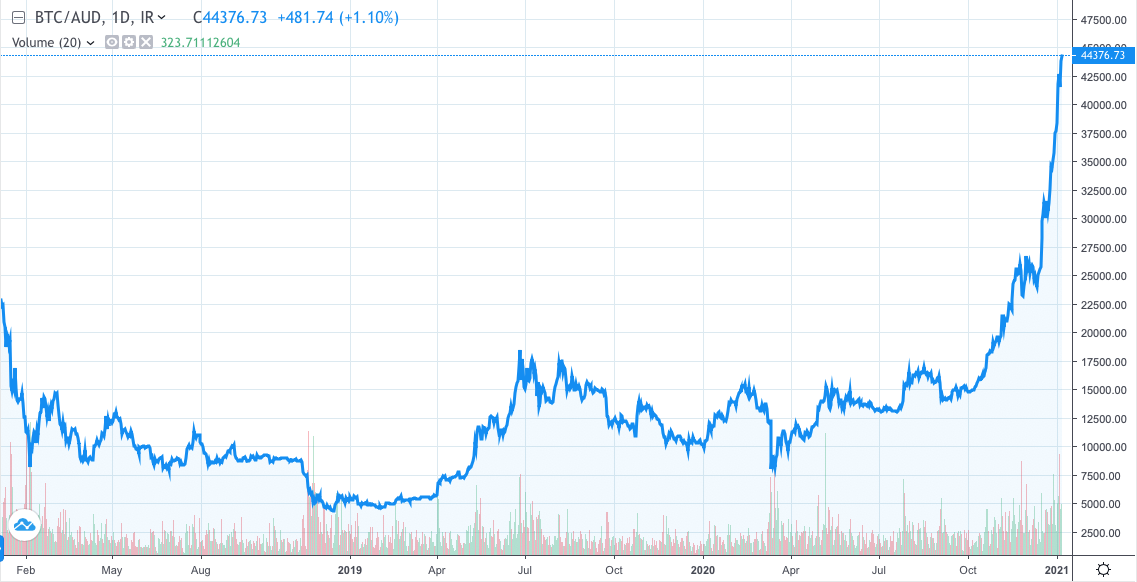Here’s why $100K Bitcoin could arrive ‘within three to eight months’

Price volatility is not new to crypto investors. Forecasts suggest Bitcoin's price could hit $128,300 this year. Image: Getty
- $100K Bitcoin speculation grows as sophisticated and retail investors climb on board
- ‘Driving the price action is clearly that institutions have now found a place in their portfolio for Bitcoin’
- Stock-to-flow modelling, valuations based on gold, point to a Bitcoin price this year of $128,300
Talk of $100K Bitcoin is growing louder after the cryptocurrency king surged to a fresh all-time high Wednesday of $US35,240 ($45,345) on a raft of reasons including political uncertainty in the US, a weaker US dollar and relaxed central bank monetary policy.
Cryptocurrencies are also starting to earn a place in the investment portfolios of conservative institutions because of their rapid price growth and as a hedge to other assets and currencies.
“Driving the price action is clearly that institutions have now found a place in their portfolio for Bitcoin, whereas previously that was a position for gold,” Leigh Travers, executive director of ASX blockchain technology company DigitalX (ASX:DCC) told Stockhead.
DigitalX operates the DigitalX Bitcoin Fund that is designed to track the price of Bitcoin.
The fund provides investors with direct exposure to the cryptocurrency without the hassles of acquiring, securing and disposing of the cryptoasset.
The Bitcoin Fund grew 87.5 per cent in the year period ended October 2020, compared with a growth rate for gold of 23.3 per cent, and negative 9.8 per cent for the ASX All Ordinaries index over the same period.
DigitalX regularly buys Bitcoin for its fund which had $10m under management according to latest figures for the September 2020-ended quarter.
Asset security is the number one priority for DigitalX and its Bitcoin Fund and the company goes to great lengths to protect and safeguard its Bitcoin.
DigitalX has a 15 per cent stake in the management of xbullion, a blockchain-based gold bullion product that is audited, insured and securely vaulted.
Traditional money managers looking at Bitcoin
A wave of traditionally conservative institutions is moving into the market for cryptoassets, such as family investment offices, pension funds, and portfolio managers.
“They are not doing it for a short-term trade because they think it is a speculative asset,” said Travers.
“They are doing that as part of diversifying their assets, to get uncorrelated and outsized returns, and to make the first part of an allocation.
“They are not looking to sell if the price adds 50 per cent in two weeks. They are much stickier investors that are starting to allocate, and they are some of the world’s largest investors.
“These investors that are coming to Bitcoin are there for the longer term, and are buying each day or each month to build up their positions.”
The upsurge in institutional and other large investor interest in Bitcoin is absorbing the available supply of the digital currency.
Digital payments companies PayPal and Square are regularly transacting in Bitcoin and other cryptocurrencies and are purchasing them to use in their businesses.
Stunning price forecasts
Some stunning price targets are starting to emerge for Bitcoin, the king of the cryptoassets.
US investment bank JP Morgan said it is possible for BTC to reach $US100,000 ($128,300) in 2021, according to reports.
Travers said it was feasible that Bitcoin could trade at levels of $US50,000 to $US60,000 this year.
“If Bitcoin can push through $US20,000 it shows it has a place in investment portfolios,” he said.
Many of the ambitious price targets for Bitcoin are based on its market value relative to gold, and Bitcoin’s price will have to increase to $US500,000 to match that of the gold market.
Travers said the most reliable price indications he had seen for Bitcoin were from investment group PlanB which used a stock-to-flow model to value the cryptoasset.
PlanB appears to be forecasting a price for Bitcoin of $US100,000 within three to eight months, according to posts on bulletin boards.
Bitcoin market technical analyst, Katie Stockton, told Coindesk the crypto asset’s current price rally looked set to continue based on technical signs.
“The signs of exhaustion that appeared in December were absorbed via a brief consolidation phase, and there are no active overbought sell signals,” she said.
Price volatility has been a hallmark of Bitcoin and other cryptoassets over past years.

Inelastic supply driving pricing
The monetary policy around Bitcoin is one important attraction for institutional investors.
Bitcoin’s supply is strictly limited to 21 million coins in total, and to date miners have issued around 18 million coins.
“The supply of Bitcoin is quite inelastic in that if the price triples we are not seeing a triple amount of selling,” said Travers.
In economics, the supply of a good is considered inelastic if its supply is unresponsive to an increase in its price. Normally, higher prices for a good result in more of it being supplied.
The four-yearly halving event in Bitcoin reduces the payment data miners receive for producing the cryptoasset and contributes to its rigid monetary policy.
There is also a network effect at play for Bitcoin, as with more market participants entering the crypto space, more digital infrastructure is created, leading to more value creation.
The same is mirrored in social media networks, and internet search engine networks, which create more intrinsic value as they increase in size and scope.
“As we see more players enter [Bitcoin] the valuation increases,” Travers said.
Bitcoin’s continued rise in price is all the more confounding given the cryptoasset suffered a huge price spike and collapse in 2017.
“There are very few assets that have fallen 80 per cent and have gone on to higher highs. It is proof that the underlying asset has value,” said Travers.
Central bank monetary policy around rock-bottom interest rates, low bond yields, and increasing volumes of currency is also playing into rising demand for cryptocurrencies.
“The US dollar is under pressure because of negative real interest rates and inflation is genuinely here, meaning you cannot store money in US dollars in the medium term and hope that it will retain value,” Travers stated.
Possible ETF
Cryptocurrency investors are patiently waiting for US financial authorities to green light an exchange traded fund (ETF), a derivative product for Bitcoin and other cryptocurrencies.
But Travers thinks it may be some time before this happens and really opens the floodgates to institutional investors and pension funds to invest in cryptoassets.
“I would expect an ETF will be around in the next two years based on new regulations and the positive stance [of regulators] towards Bitcoin,” Travers said.
Investment company Van Eck filed an application to the US Securities Exchange Commission at the end of December to launch an Exchange Traded Fund for Bitcoin and possibly other cryptoassets.
Regulatory issues can be a bugbear for cryptoassets, as the case of XRP has shown.
XRP’s distribution company Ripple is caught up in a legal tussle with the SEC over whether or not the crypto product is a financial security and should be regulated as such.
Another cryptocurrency, Ethereum is also trading at record highs this week at $US1,105 ($1,420).
Etherem’s operating system is based on a de-centralised computer network which hosts peer-to-peer transactions and has a broader application beyond digital currency.
Blockchain technology applications
DigitalX also develops its own digital blockchain technology, an example of which is its Drawbridge project.
The online app streamlines corporate governance and reduces insider trading risks for ASX and globally listed companies by digitising compliance activity that can be time consuming and costly.
Drawbridge is DigitalX’s first step to use blockchain technology to develop products for the regulatory technology market.
The ASX company also carries out consultancy work, identifying ways that clients can use blockchain technology to solve business issues and to create new value.
“We help firms and large enterprises understand how blockchain can be used in their business and with their channel partners,” said Travers.
A lot of the company’s consultancy work is carried out at its purpose-built Blockchain Centre in Perth, which also hosts a number of technology and investment companies.
“The centre is fully booked and there is demand from people who want to work there,” said Travers.
The views, information, or opinions expressed in the interview in this article are solely those of the interviewee and do not represent the views of Stockhead.
Stockhead has not provided, endorsed or otherwise assumed responsibility for any financial product advice contained in this article.
Related Topics
UNLOCK INSIGHTS
Discover the untold stories of emerging ASX stocks.
Daily news and expert analysis, it's free to subscribe.
By proceeding, you confirm you understand that we handle personal information in accordance with our Privacy Policy.








